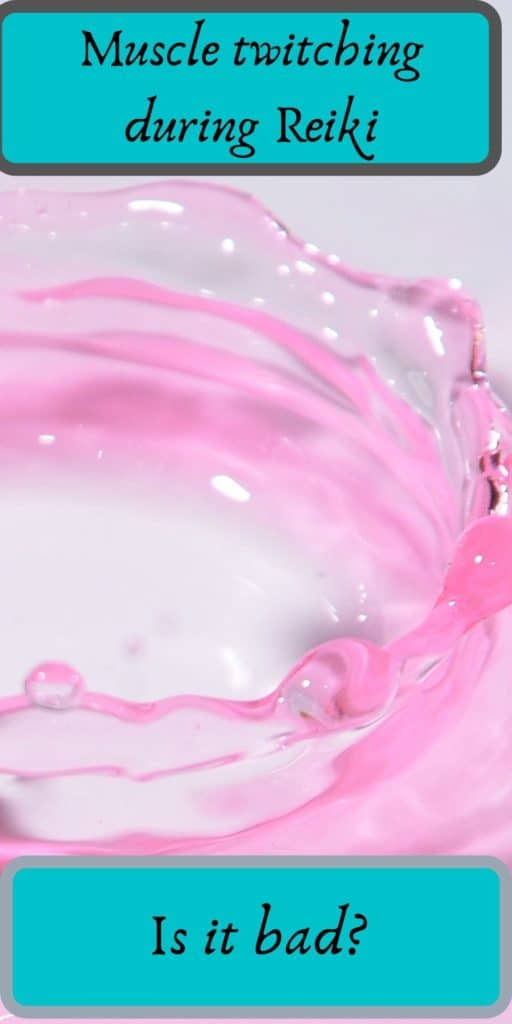Muscle twitching during a Reiki session can be attributed to several factors:
- Energy release: Twitching can be a sign that energy is flowing again, indicating that blocked energy is being released3. This can be due to tension or toxins around the area being treated2.
- Kriya: In some cases, muscle twitching can be a result of a “kriya,” which is a spontaneous movement or activity caused by the flow of Kundalini energy during a spiritual awakening experience1. This energy helps facilitate the release of blockages and advanced healing1.
- Resistance to change: Shaking during Reiki can occur when the body is trying to process and release pent-up energy, but the person is resisting it5. This can be due to various factors, such as not expressing oneself, processing grief, love, and lust, or unmet needs5.
- Physical energy release: Muscle twitching can also be a normal reaction to the physical energy released during a Reiki session.
It is essential to remember that muscle twitching during Reiki is generally a positive sign, indicating that the body is processing and releasing energy
Causes of Muscle Twitching
Let’s delve into a more detailed explanation of the causes of muscle twitching during Reiki sessions:
1. Energy Release
- What Happens: During a Reiki session, the practitioner works to unblock and balance the energy within the body. Muscle twitching in this context is often a sign that previously stagnant or blocked energy is beginning to flow again.
- Why It Occurs: The body can hold onto energy in the form of tension or accumulate toxins in certain areas. When Reiki energy targets these areas, it can initiate a release, leading to involuntary muscle twitches. This is akin to a physical manifestation of energy movement and clearing.
2. Kriya Phenomenon
- Understanding Kriya: ‘Kriya’ refers to involuntary physical movements that occur as a result of spiritual awakening. In the context of Reiki, this is often linked to the awakening or movement of Kundalini energy.
- Kundalini Energy: This is a form of primal energy believed to be located at the base of the spine. During spiritual practices like Reiki, this energy can be activated and travel up through the chakras (energy centers), leading to physical reactions like twitching.
- Healing and Blockage Release: As Kundalini energy moves, it can encounter and clear blockages in the energy system, which can manifest as muscle twitches. This process is considered beneficial, aiding in deeper healing and spiritual growth.
3. Resistance to Emotional Release
- Emotional Energy: Reiki doesn’t just work on a physical level; it also touches upon emotional and mental energies. Sometimes, the body stores emotional energy, such as unexpressed feelings, grief, or trauma.
- The Process of Release: When Reiki energy encounters these stored emotions, it attempts to release them. If there’s resistance to letting go of these emotions – perhaps due to fear, denial, or deep-seated issues – the body might react through twitching or shaking.
- Understanding Resistance: This resistance can be conscious or subconscious. It’s a sign that the body and mind are processing and attempting to release these energies, even if there’s some initial reluctance or difficulty in doing so.
4. Physical Energy Discharge
- Normal Bodily Reaction: In some cases, muscle twitching during Reiki is simply a physiological response to the relaxation and energy movement within the body. It’s not necessarily linked to emotional or spiritual blockages.
- Why It’s Normal: Just as one might experience twitching while falling asleep or during deep relaxation, similar responses can occur during a Reiki session as the body enters a deeply relaxed state and energy flows more freely.

General Consideration
- Positive Indicator: Generally, muscle twitching during Reiki is seen as a positive sign, indicating that the body is actively engaged in the healing process, whether it’s releasing physical tension, clearing energetic blockages, or processing emotional energies.
- When to Seek Advice: Despite being a positive sign, if there’s any concern or if the twitching is persistent and uncomfortable, it’s important to discuss it with the Reiki practitioner. They can provide insights based on their experience and may adjust the session accordingly. Additionally, consulting a healthcare professional can help rule out any underlying medical conditions.
In summary, muscle twitching during Reiki sessions can have various causes, ranging from the release of physical tension and toxins to the deeper processing of emotional and spiritual energies. It’s a common and generally positive sign of the body’s response to the healing energy of Reiki, but awareness and open communication with the practitioner are key to ensuring a comfortable and beneficial experience.
| Key Takeaways Reiki sessions may elicit involuntary reactions such as jerking, twitching, and spasms that rid the body of blockages or resistance, facilitating a sense of healing. |
| Not every Reiki experience will result in such involuntary reactions, depending on one’s natural preparedness. |
| Convulsive movements of the whole body or a specific part of the body are entirely different experiences that can be harmful to the patient. |
| If a patient experiences such convulsions, the practitioner should remove their hands, back away, and desist from carrying on with the session. |
| Practitioners may tap into underlying issues that might have caused deep trauma or shame in the past, eliciting severe convulsions, and they may need to give time to recover. |
How To Prevent Muscle Twitching

Avoiding Fear
One way of addressing muscle twitching during a Reiki session is to avoid being afraid of them. Exhibiting a fearful response establishes a stumbling block in addressing the fundamental challenges that one has hence shut the door towards healing. It forms the basis as to why relaxation and meditation is a vital component in solving existing internal problems. The first step in addressing the inner challenges is to get rid of the fear through meditation and relaxation.
Generally, muscle twitching shouldn’t be a regular part of your sessions. They should be resolved at the onset of the first session if they are issue-related. Continual exhibiting of muscle twitching during Reiki only indicates a sign of not going deep enough.
Grounding
Grounding is sometimes overly convoluted. It may only mean sitting down and relaxing or taking a stroll in nature or simply a garden. It may also take the form of simple, gentle exercises to help you settle more into your body. As grounding takes effect, you need to breathe into the negative feelings emanating from your body calmly.
Advanced Reiki practitioners sometimes offer such a relaxing environment for their patients before commencing sessions to be in touch with their inner feelings, though not common. They also recommend simple strategies such as grounding or rolling gently on the ground to minimize the effects of involuntary twitching.
Clean up Your Internal Closet
As earlier discussed, internal twitching was indicative of an internal struggle as the body tries to rid itself of the blockages or negative emotions. For one to fully enjoy Reiki sessions and minimize such effects, they must try to straighten the problematic issues in their lives and release the negative energies that may have accumulated in their lifetime.
Such energies tend to have an outburst, leading to violent convulsions and extreme twitching, which may not be productive health-wise. Why wait to have such an experience at the Reiki table, yet you have the chance to sort out your internal mess?
Consult Your Doctor When in Doubt
Reiki practitioners always advise that you consult your doctor if you have involuntary physical movements. Such movements may pinpoint underlying bodily issues. It is when still in doubt. There exist many bodily and neurological disorders that may affect an individual.
Book an appointment with your doctor to rule out some of these possibilities.
It is also imperative you seek your doctor’s opinion if still in doubt. Both the practitioner and the patient need to experience the full benefits and the truthful outcomes of the Reiki session. Experiencing such twitching should be a result of the negative energy released from the body and not as a result of medical history or conditions.
What about shaking during reiki?
Shaking during Reiki energy work sessions is a common occurrence and can happen for various reasons. Sometimes, the body has been craving touch, affection, or caring, and shaking is a natural response
Other times, shaking can be a result of Kriyas, which are spontaneous movements of the body during Reiki Whole body jerks, shaking, or sitting up during treatment can also occur when the healing energy is strong
Shaking can also be a sign that the person receiving Reiki is in great need It is important to note that shaking during Reiki is not necessarily a negative thing and can be a sign of the body releasing stored energy
Conclusion
Modern society has come of age, where they seek alternative treatment characterized by less harmful side effects of medication. Despite the widespread uptake of unconventional medical practices such as Reiki, they still exhibit side effects such as twitching, jerking, among others. Minimizing such effects is highly dependent on the participation of both parties in ensuring a seamless and productive experience.
see Also:
Ultimate Reiki Symbol Guide and Directory



